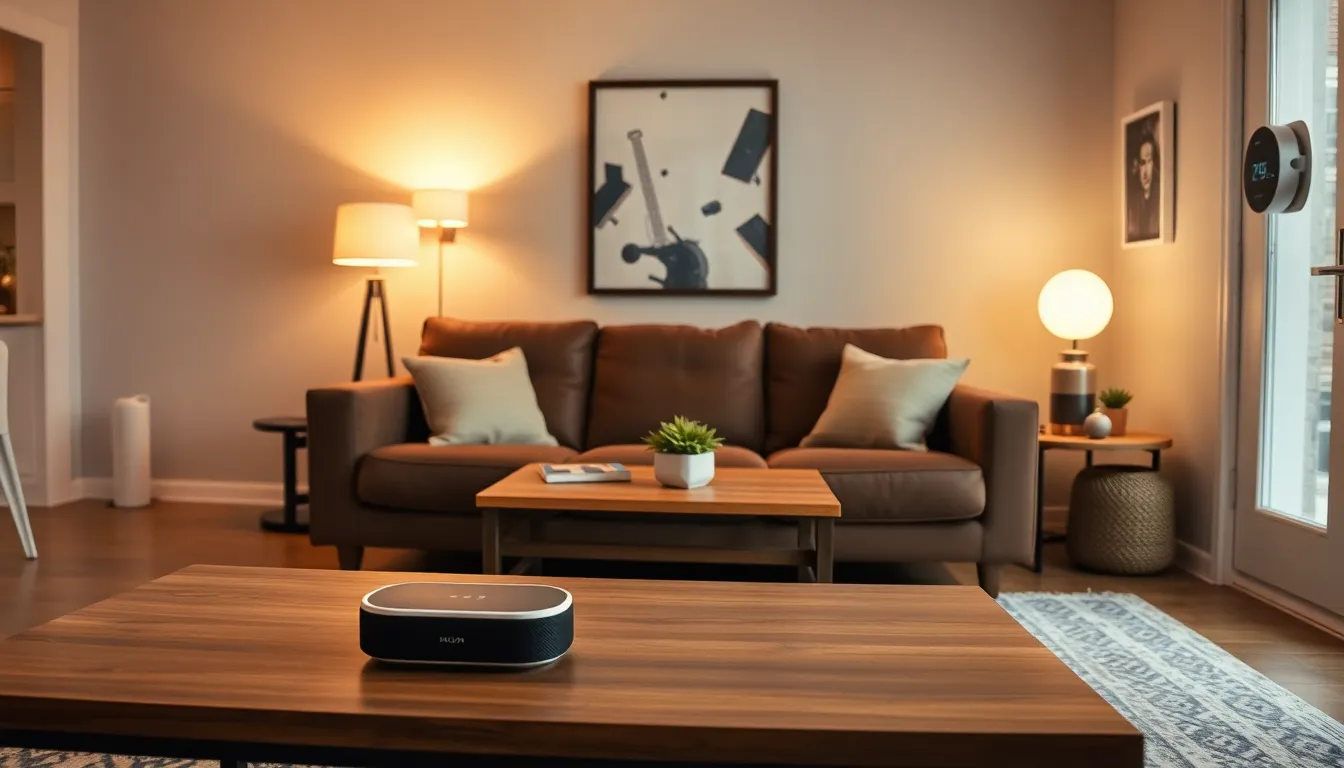Table of Contents
ToggleImagine a world where your coffee brews itself, your lights dance to your favorite tunes, and your home knows when you’re feeling chilly. Welcome to the realm of wireless home devices, where convenience meets a sprinkle of magic. These nifty gadgets are not just about tech-savvy living; they’re about turning everyday tasks into a breeze, leaving you more time for the important things—like binge-watching your favorite shows in peace.
Overview of Wireless Home Devices
Wireless home devices facilitate seamless connectivity and control for various household functions. These devices include smart speakers, security cameras, thermostats, and lighting systems. Smart speakers, like Amazon Echo or Google Nest, allow users to control other devices through voice commands. Security cameras enhance home safety, providing monitoring via smartphones or tablets.
Thermostats optimize energy usage by adjusting temperature settings based on user preferences. They can learn behaviors and develop schedules over time for increased efficiency. Lighting systems, such as Philips Hue, enable users to customize brightness and colors to create different moods.
According to recent statistics, the global smart home market is projected to reach $135 billion by 2025. This growth reflects a rising demand for automation and remote control features. Users appreciate the convenience in managing their home environment from anywhere using mobile apps. Connectivity remains a key advantage as it allows devices to work in tandem, enhancing the overall user experience.
Interconnectivity often promotes energy savings and improved security. Integration with platforms like IFTTT empowers users to set up complex automation routines. For instance, users can program lights to turn on at sunset or to activate security cameras when they leave home.
Overall, wireless home devices transform modern living, offering both practical benefits and lifestyle enhancements. The convenience brought by these technologies makes daily life simpler, allowing for a more enjoyable and efficient home environment.
Types of Wireless Home Devices

Wireless home devices come in various forms, each designed to enhance comfort and efficiency.
Smart Speakers
Smart speakers serve as a central hub for voice-activated control. Devices like Amazon Echo and Google Nest allow users to manage smart home systems with simple voice commands. Music playback, information requests, and home automation control are just a few functionalities available. Users can link these speakers to other devices, creating a seamlessly controlled environment. The integration with services like Spotify enhances entertainment options. Voice recognition technology improves response accuracy, leading to engaging user experiences.
Smart Lighting
Smart lighting systems enable users to customize their home ambiance easily. Adjustable brightness and color options suit different moods and occasions. Products like Philips Hue connect through Wi-Fi, allowing control via smartphone apps. Users can schedule lighting changes, contributing to energy efficiency. Integrating smart lighting with voice assistants enhances convenience. Such setups also support automation, such as dimming lights during movie nights or brightening at sunrise.
Home Security Systems
Home security systems provide essential safety features for any household. Wireless cameras enable real-time monitoring via smartphone apps. High-definition video quality ensures clear images, even at night. Smart locks increase access control, allowing users to manage entry via mobile devices. Alerts and notifications keep homeowners informed of security events. Integration with artificial intelligence can enhance user experience, ensuring accurate threat detection.
Smart Thermostats
Smart thermostats make temperature control efficient and user-friendly. Systems like Nest learn user behaviors, optimizing heating and cooling schedules. Automatic adjustments based on occupancy lead to significant energy savings. Mobile app functionalities allow users to control settings remotely. Integrating with weather forecasts further enhances performance. Multi-zone capabilities enable customized climate control throughout the home, ensuring comfort in every room.
Benefits of Wireless Home Devices
Wireless home devices provide significant advantages, enhancing everyday life while promoting efficiency and safety.
Convenience and Automation
Users experience greater convenience with wireless devices. Smart speakers allow voice-activated commands for music, lights, and information. Automation minimizes time spent on mundane tasks, enabling control from anywhere through mobile apps. Customizable settings align with user preferences, enhancing daily routines. Many systems integrate seamlessly, coordinating actions between devices. For example, a morning routine can include gradual lighting adjustments and coffee brewing, all automated. Overall, convenience emerges as a primary benefit, making life simpler and more streamlined.
Energy Efficiency
Energy efficiency thrives with the implementation of wireless home devices. Smart thermostats learn user patterns, optimizing heating and cooling settings according to real-time needs. Users save on energy bills as systems adjust temperatures automatically, reducing waste. Smart lighting systems offer automation for turning off lights when not in use, contributing to energy conservation. Many devices allow monitoring and management through mobile apps, further promoting efficiency. Reports indicate that integrating these systems can lead to energy savings of up to 30%. Energy-efficient solutions enhance comfort while promoting sustainable living practices.
Considerations Before Purchase
Wireless home devices offer convenience and automation, yet prior considerations play a vital role in maximizing their benefits.
Compatibility with Existing Systems
Users must assess compatibility before purchasing wireless home devices. Smart home ecosystems vary, and ensuring devices work with existing systems is crucial. For instance, some devices require specific platforms like Google Assistant or Amazon Alexa. Integration enhances functionality, enabling seamless management of multiple devices. Checking compatibility with current routers and Wi-Fi networks is also essential, as connection issues may arise otherwise. Researching user reviews and expert recommendations helps identify devices that harmonize well with established systems. Ensuring compatibility saves time and effort during setup and prevents future frustrations.
Security Risks
Security risks pose significant concerns with wireless home devices. Many devices connect to the internet, making them vulnerable to hacking and unauthorized access. Weak passwords and outdated firmware increase these risks, thus regular updates and strong, unique passwords are recommended for every device. Users should prioritize devices with built-in security features, such as encryption and two-factor authentication, adding extra layers of protection. Additionally, monitoring device activity can help users identify suspicious behavior promptly. Keeping a close watch on security measures ensures a safer smart home environment, allowing users to fully enjoy the benefits of automation without undue stress.
Wireless home devices are reshaping the way people interact with their living spaces. They offer unparalleled convenience and efficiency that allow users to focus on what truly matters. As technology continues to advance, these devices will only become more integrated into daily life.
The potential for energy savings and enhanced security makes them an attractive option for homeowners. However, it’s essential to approach the smart home landscape with care, ensuring compatibility and prioritizing security measures. By doing so, individuals can fully embrace the benefits of wireless technology while enjoying a seamless and safe smart home experience.






